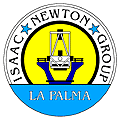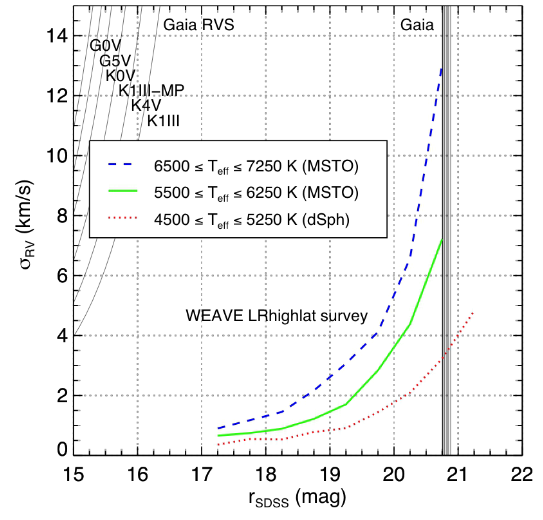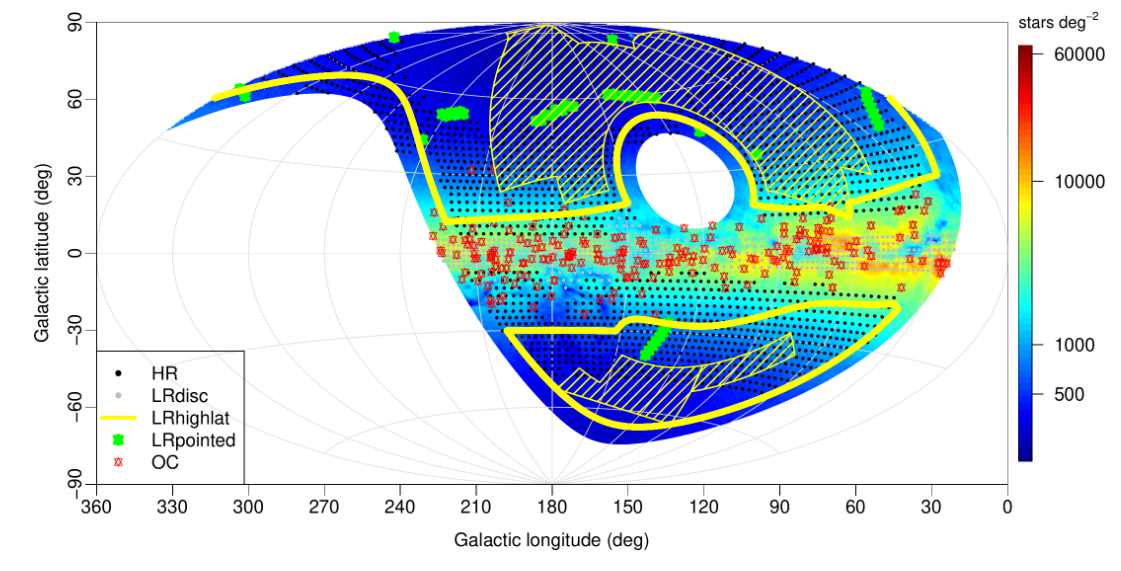The WEAVE Galactic Archaeology survey
Science Team Lead: Vanessa Hill
Open clusters Survey Team Lead: Antonella Vallenari
Deputy Science Team Lead: Giuseppina Battaglia
Sub-survey co-leads:
LR high-latitude survey: Giuseppina Battaglia, Vasily Belokurov, Alis Deason
LR disc survey: Teresa Antoja, Benoit Famaey
HR survey: Vanessa Hill, Eline Tolstoy
Open Clusters survey: Antonella Valenari, Angela Bragaglia
Calibrations: Sara Lucatello, Sofia Feltzing
Survey Working Group:
LR high-latitude survey: Guillaume Thomas
LR disc survey: Arnaud Siebert, Mercè Romero
HR survey: Frédéric Royer
Open Clusters survey: Angela Bragaglia, Ricardo Carrera
Calibrations: Sara Lucatello
A separate page listing individuals with key roles within each of the science team can be found here.
Note: The text and figures on this webpage are extracts from the article Jin et al. arXiv/2212.03981, accepted for publication on MNRAS.
How did our Galaxy and its components assemble and evolve over time? This question is key to the general understanding of galaxy formation over cosmic times, as the Milky Way is the system for which we can hope to constrain in most detail the physical processes that play a role in the formation and evolution of galaxies. These processes leave behind specific signatures that are encoded in the location, kinematics and chemistry of stars (e.g. Freeman & Bland-Hawthorn 2002). The ultimate goal of Galactic Archaeology as a field of study is to obtain a comprehensive census of the positions, orbits, ages and chemical compositions of stars in all major stellar structures of our own Galaxy to enable a complete reconstruction of its formation and subsequent evolution.
Many questions remain open in understanding how the complex structure of the Milky Way was assembled, with its stellar populations occupying a bulge, a thin and thick disc and a halo. Whether the different stellar populations have truly different origins, what the relative importance is of internal (in-situ star formation, secular evolution of the disc, etc.) and external (accretion events, gas accretion through filaments, etc.) processes in forming and shaping the Galaxy, and how universal these processes are in the evolution of galaxies in general, are questions to which Galactic Archaeology as a field of astronomical study tries to find answers.
The last decade has seen the opening of new windows on the Universe, made possible by the development of new instrumentation. One of these new windows is ultra-high-precision astrometry, enabled by the European Space Agency mission Gaia (Gaia Collaboration et al. 2016), launched in December 2013. During its nominal five-year mission (and up to 10 years pending approvals of mission extensions), Gaia is already producing – and will continue to produce – the most accurate astrometric data (positions, parallaxes and hence geometrical distances, and proper motions) ever produced in the optical domain for more than a billion stars in the Milky Way. In addition, Gaia is providing very accurate photometry in three band-passes (Riello et al. 2021a), complemented since its DR3 by shallower photometry in a fourth bandpass (𝐺RVS, Sartoretti et al. 2022), as well as spectrophotometric information from the Gaia BP/RP spectrophotometer (De Angeli et al. 2022). Thanks to these exquisite data, Gaia is already providing unprecedented insights into – or constraints on - subject matters such as star formation in the Galactic disc (e.g. Ruiz-Lara et al. 2020), the dynamics of the Milky Way disc (e.g. Antoja et al. 2018; Bennett & Bovy 2019; Laporte et al. 2019), the mass of the Milky Way (e.g. Posti & Helmi 2019; Wegg et al. 2019; Cautun et al. 2020), the dynamics of satellite galaxies (e.g. Battaglia et al. 2022), the effect of the Large Magellanic Cloud on the dynamics of the Milky Way and stellar streams, (e.g. Vasiliev et al. 2021), stellar streams in the Galactic halo (e.g. Malhan et al. 2018), a major accretion event (Gaia Enceladus Sausage, e.g. Belokurov et al. 2018; Helmi et al. 2018), the chemodynamics of stellar streams (Mackereth et al. 2019) and determination of stellar ages in the disc (Bland-Hawthorn et al. 2019) through combining Gaia data with those from complementary surveys, and the Galactic disc as seen from its component stellar clusters (Cantat-Gaudin et al. 2020).
Fully exploiting the Gaia data requires obtaining accurate radial velocities and elemental abundances for stars that are too faint for Gaia's Radial Velocity Spectrometer (RVS). The WEAVE Galactic Archaeology survey is tailored to complement Gaia in two primary ways:
- by providing measurements based on low-resolution spectra of radial velocities (expected precision to about 1-2 km/s), effective temperature, surface gravity and metallicity (expected precision to about 0.2 dex) for 1.8–2.6 million targets in the faint part of the Gaia catalogues with magnitudes in the range 16 < 𝐺 < 20.7 (see Figure 1);
- by yielding accurate measurements based on high-resolution spectra of abundance ratios covering the main nucleosynthetic channels (light, 𝛼-, Fe-peak, and 𝑠- and 𝑟-process neutron-capture elements, to better than 0.05–0.2 dex), depending on the element and type of star, and radial velocities (to better than 0.5 km/s) for 1.1–1.6 million stars in the magnitude range 12 < 𝐺 < 16.
WEAVE's vantage point from the Northern Hemisphere is crucial for targeting the outer MW disk. The WEAVE Galactic Archaeology survey will be unique; no other existing or proposed optical facility (e.g. LAMOST, DESI, SDSS) will provide such a survey to similar depth or spectral resolution, while the southern sky inaccessible to WEAVE will be covered by ESO's forthcoming 4MOST facility.
Figure 1: Expected radial velocity accuracies for WEAVE in its 𝑅 = 5000 mode (thick solid coloured lines) for different stellar effective temperature ranges, based on the WEAVE ‘Operational Rehearsal’ (OpR) simulations (specifically OpR2.5), together with the post-launch predictions for Gaia at the end of the nominal five-year mission (thin solid coloured lines) for different stellar types. Dashed coloured lines represent Gaia end-of-mission photometric limits for astrometry of different spectral types
The WEAVE GA sub-surveys
The WEAVE Galactic Archaeology surveys fall into four independent categories as listed below, according to the spectral resolution of the observations (LR or HR) and the stellar populations or Galactic locations targeted, as illustrated in Figure 2. These complementary surveys, together with the SCIP and White Dwarfs surveys, nearly completely sample the Milky Way’s stellar populations accessible from the Northern Hemisphere.
Figure 2: Footprint of the WEAVE GA surveys on the sky in Galactic coordinates in an Aitoff projection overlaid on the Gaia DR3 (Gaia Collaboration et al. 2022a) density contours of stars with parallax measures, 𝐺 < 16, and -10° < 𝛿 < 80° (in stars deg-2). HR chemo-dynamical survey: black dots; Open Clusters survey: red stars; Disc dynamics LR survey: dark green dots; High-latitude LR survey (shared with the WEAVE-LOFAR and WEAVE-QSO surveys) yellow outline, where the hashed yellow outline region shows the provisional area to be surveyed at about 100 per cent coverage factor, while the remaining area for this survey will be surveyed with at about 30 per cent coverage factor. Known stellar streams and dwarf spheroidal galaxies covered within the pointed part of the High-latitude LR survey: light green stars. The available declination range arises from the impact of differential atmospheric refraction on targets near the edge of the field on the typical 1-hour WEAVE-Survey OB. Near-polar targets like NGC 188 require short exposures outside of the normal WEAVE-Survey OBs.
The high-latitude LR survey (‘LR-highlat’)
This low-resolution wide-area survey of 6000–8500 deg2 at high Galactic latitude will observe 1.1 million (five-year survey) to 1.55 million (seven-year survey) stars in the magnitude range 15 <𝑟SDSS <20–21 to complement Gaia with line-of-sight velocities and metallicities for stars too faint for the RVS, and thereby yield the best-yet constraints on the halo potential’s lumpiness and total mass to large distances (100 kpc, e.g. Cautun et al. 2020), address the formation of the Galactic halo, and characterise its progenitors (including substructures such as streams and dwarf galaxies). The search for traces of accretion events has recently been exemplified by Gaia’s finding of a significant merger, known as Gaia Enceladus or the Gaia Sausage, that has been shown to make up a significant fraction of the inner Galactic halo (e.g. Belokurov et al. 2018; Helmi et al. 2018; Haywood et al. 2018; Myeong et al. 2019; Gallart et al. 2019; Naidu et al. 2020; Malhan et al. 2022). A number of new cold streams have also been discovered thanks to Gaia astrometry (e.g. Malhan et al. 2018; Ibata et al. 2021), which anticipates the wealth of discoveries awaiting us with the combination of Gaia and WEAVE. While the main target of this survey is the Galactic halo, the survey will also probe the thick disc of the Milky Way, complementing the HR survey (see below). To achieve these goals, the LR-highlat wide-area survey will target the following: colour- and magnitude-selected main-sequence turnoff (MSTO) stars; red-giant-branch (RGB) stars selected by colour, magnitude and Gaia astrometric data (parallaxes andproper motions, to reject local red main-sequence stars from the selection); extremely metal-poor star candidates selected from narrow-band photometry (e.g. Pristine: Starkenburg et al. 2017), broad-band photometry (e.g. SDSSS, Abolfathi et al. 2018) or Gaia’s on-board spectrophotometry (Gaia Data Release 3 and onwards; see Sartoretti et al. 2022); blue-horizontal-branch (BHB) stars and blue stragglers (using, for example, a combination of colours including the 𝑢 band, e.g. Deason et al. 2012); RR Lyrae stars (e.g. Sesar et al. 2017; Holl et al. 2018; Iorio & Belokurov 2021; Clementini et al. 2022); hyper-velocity stars (e.g. Brown et al. 2018; Contigiani et al. 2019; Evans et al. 2022; Marchetti et al. 2022). This survey is foreseen to share fibres on the sky with the WEAVE-LOFAR and WEAVE-QSO surveys, and hence share the same footprint. In addition to this wide-area component, the LR-highlat survey will drill a few deeper (down to at least 𝑟SDSS = 21) four-hour pointings (and even up to seven hours in some specific cases) around specific objects of interest, namely dwarf spheroidal galaxies and known stellar streams, where the multi-epoch data will allow for the detection of binary stars to refine the line-of-sight velocity dispersion profiles of these objects and to understand better the dark-matter distribution. This pointed survey is expected to cover a total of 200 deg2 on the sky.
The disc-dynamics LR survey (‘LR-disc’)
This low-resolution, high radial-velocity accuracy survey will observe 500 lines of sight through the Galactic disc at very low latitudes to probe fundamental Galactic disc dynamics processes in a volume inaccessible to Gaia alone. The survey will observe 7 x 105 (five-year survey) to 1.1x106 (seven-year survey) stars selected mainly to be red-clump giants with Pan-STARRS1 (Chambers et al. 2016) 𝑟-band magnitudes in the range 15 < 𝑟PanSTARRS < 19, spanning evenly the distance range 2–8 kpc from the Sun, or from 2–15 kpc in Galactocentric radius. Towards the outer disc, all RGB stars will be allowed into the selection function. The fundamental goal of this survey is to understand the phase-space distribution of stars of the Galactic disc, in particular those effects associated with mergers and/or resonances of non-axisymmetric perturbations (bar and spiral arms), both in the inner and outer disc (see also Famaey et al. 2016). This survey is likely to provide unique insights into the effects of various internal and external perturbers on the secular evolution of the Galactic disc at large scales, in a similar fashion to the local non-stationarity found locally in Gaia DR2 (e.g. Gaia Collaboration et al. 2018b; Antoja et al. 2018; Bennett & Bovy 2019; Bland-Hawthorn & Tepper-García 2021; Bovy et al. 2019; Ruiz-Lara et al. 2020). Thanks to the Northern location of WEAVE, this survey will also provide a unique view of the Galactic Anticentre (cf. Gaia Collaboration et al. 2021).
The HR chemo-dynamical survey (‘HR’)
This high-resolution survey, covering 4000–5600 deg2 at intermediate and high Galactic latitudes, will target stars with 12 < 𝐺 < 16 to complement Gaia’s phase-space information with full chemical information, thereby opening the full 15+ dimensional space of the chemo-dynamical picture of the three major Galactic populations: the thin and thick discs and the halo. The thick discs will be sampled to large distances, allowing us to study its connection to the thin disc and the inner halo, together with its age-density and age-kinematics relations through mono-abundance and mono-age groups (e.g. Mackereth et al. 2017; Mackereth & Bovy 2020). Ancient accretions that have now dissolved in the halo and discs will be detected chemo-dynamically through the wealth of abundance information for different nucleosynthetic channels that will be provided by the HR spectra (eg. Mackereth et al. 2019; Di Matteo et al. 2019). In the volume within which Gaia parallaxes are most accurate (i.e. accurate to better than 10 per cent), high-quality stellar parameters (effective temperature, gravity, metallicity and [𝛼/Fe]) for >7 x 105 (five-year survey) to 1.1 x 106 (seven-year survey) MSTO and sub-giant stars will also allow us to constrain stellar ages to exquisite precision (Bland-Hawthorn et al. 2019; Kor-dopatis et al. 2022) within a sphere of radius 2 kpc. The target selection function, based on Gaia DR3 (or from later releases) absolute magnitudes and their associated uncertainties, will include all stars with absolute magnitudes 𝑀𝐺 < 4.5, thus also selecting intrinsically bright targets such as RGB stars that will probe the Milky Way’s thin and thick discs and halo to distances of 10 kpc and beyond. Targets of special interest will be given higher priority to ensure proper sampling. These include very and extremely metal-poor stars with prior information on metallicity (e.g. Pristine: Starkenburg et al. 2017), RR Lyrae (see e.g. Clementini et al. 2022) and Cepheid (both in this HR survey, as well as in the LRdisc survey above; see e.g. Ripepi et al. 2022) variable stars, known exoplanet hosts, bright members of known streams (e.g. Martin et al. 2022), and stars with high tangential velocities to increase the halo fraction in the sample (from Gaia DR3; see e.g. Gaia Collaboration et al. 2018a; Koppelman & Helmi 2021).
The Open Clusters survey (‘OC’)
This is a survey (mostly in high resolution) of a sizeable sample ( 120) of old and young open clusters (OCs) and tiling three cluster-formation regions, aimed at obtaining homogeneous information on radial velocities and chemical information. This will complement Gaia’s superb distances and proper motions of individual stars in known and newly discovered OCs (e.g. Castro-Ginard et al. 2020, 2022, and references therein) up to 5 kpc from the Sun, with a precision in distance of 1 per cent up to a distance of 1.5 kpc and 10 per cent for more distant targets, leading to an accurate and reliable definition of membership even for the most distant objects. This survey will constrain our understanding of the formation and disruption processes of OCs (Carrera et al. 2019b; Cantat-Gaudin 2022, and references therein), the chemical evolution of the Milky Way disc using OCs as probes (Carrera et al. 2019a; Cantat-Gaudin et al. 2020; Spina et al. 2022), and provide insights into star formation and early stellar evolution (Valentini et al. 2019; Magrini et al. 2021).
Astrophysical calibration
A careful validation and accurate calibration of the derived atmospheric parameters, measured abundance ratios and radial velocities will ensure that the data from the aforementioned four GA sub-surveys will be on the same scale. The WEAVE GA sub-surveys will therefore include dedicated observations for this purpose, including the observation of globular clusters, well-studied open clusters, field giant stars with stellar parameters derived from asteroseismic data from the CoRoT (e.g. Anders et al. 2017) or Kepler (e.g. Borucki et al. 2010; Kallinger et al. 2010; Yu et al. 2018) missions, and field stars (Gaia benchmark stars, Heiter et al. 2015; Hawkins et al. 2016), as well as stars in previous high-resolution spectroscopy studies (e.g. Soubiran et al. 2016). This will allow us to combine the results of the GA sub-surveys both among themselves and with several other stellar Galactic surveys including Gaia-ESO (Gilmore et al. 2012), GALAH (Buder et al. 2021), APOGEE (Majewski et al. 2017), 4MOST (de Jong et al. 2019) and others; see e.g. Soubiran et al. (2022) for a comparison of metallicity determinations for FGK stars across public data releases from several such spectroscopic surveys.
Overlap between HR and LR
In addition to dedicated calibration fields, it is highly desirable that a significant overlap is built between the high and low spectral resolution (HR and LR, respectively) Galactic Archaeology surveys in order to ensure homogeneity of the stellar parameters and individual chemical abundances that are derived between these two instrumental modes. While calibration stars (cluster and reference field stars observed specifically with both modes) provide the absolute anchor to these quantities through comparisons with independent estimates, it is desirable to build an overlap of stars surveyed in both LR and HR that would enable us to better map the systematics between stellar parameters and abundances derived from these two types of WEAVE spectra. Furthermore, it is expected that it will not be possible to measure the abundances of some elements in the restricted wavelength range of the HR mode; among these are, for example, Nitrogen (and Carbon in the green+red HR mode). A programme to utilise sub-optimal and/or relatively under-subscribed observing conditions has thus been devised to observe a fraction of the GA-HR survey observing blocks in LR mode, to be executed in weather conditions when the main surveys cannot be executed. Thanks to the limited depth of the GA-HR survey (12<G<16), this programme is expected to be executed in bright time and modest seeing conditions (seeing<2 arcsec).
This GA programme will allow us: (i) to map systematics between the LR and HR analysis of WEAVE spectra over a large part of the Hertzsprung-Russell diagram, and reflecting the target selection of the GA surveys, with sufficiently large statistics to allow this mapping to be worked out with machine-learning methods (e.g. Nandakumar et al. 2022); and (ii) to potentially build a significant sample in which the HR suite of elemental abundances is complemented by the few elements that are only accessible (or better measured) in LR.





